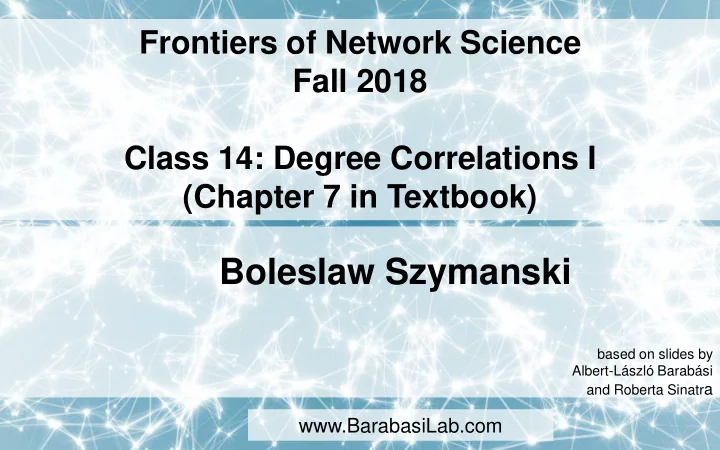

Frontiers of Network Science Fall 2018 Class 14: Degree Correlations I (Chapter 7 in Textbook) Boleslaw Szymanski based on slides by Albert-László Barabási and Roberta Sinatr a www.BarabasiLab.com
EXTENDED MODEL: Small-k cutoff P(k) ~ (k+ κ (p,q,m)) - γ (p,q,m) γ ∈ [1, ∞ ) Extended Model • prob. p : internal links Predicts a small-k cutoff • prob. q : link deletion a correct model should predict all aspects of the • prob. 1-p-q : add node degree distribution, not only the degree exponent. Degree exponent is a continuous function of p,q , m p=0.937 m=1 κ = 31.68 γ = 3.07 Actor network Network Science: Evolving Network Models
NONLINEAR PREFERENTIAL ATTACHMENT: MORE MODELS • Non-linear preferential attachment: α k Π = ( k ) ∑ α k i i → P(k) does not follow a power law for α≠ 1 ( ) β ≈ − ⇒ α <1 : stretch-exponential P ( k ) exp ( k k ) 0 ⇒ α >1 : no-scaling ( α >2 : “gelation”) P. Krapivsky, S. Redner, F. Leyvraz, Phys. Rev. Lett. 85, 4629 (2000) Network Science: Evolving Network Models
INITIAL ATTRACTIVENESS BA model: k=0 nodes cannot aquire links, as Π(k=0)=0 (the probability that a new node will attach to it is zero) α Π ≈ + α ≤ ( k ) A k , 1 A - initial attractiveness Initial attractiveness shifts the degree exponent: A γ = + 2 in m Note: the parameter A can be measured from real data, being the rate at which k=0 nodes acquire links, i.e. Π(k=0)=A Dorogovtsev, Mendes, Samukhin, Phys. Rev. Lett. 85, 4633 (2000) Network Science: Evolving Network Models
GROWTH CONSTRAINTS AND AGING CAUSE CUTOFFS • Finite lifetime to acquire new edges L. A. N. Amaral et al., PNAS 97, 11149 (2000) − ν ∏ ∝ − • Gradual aging: ( k ) k ( t t ) i i i γ ν increases with S. N. Dorogovtsev and J. F. F. Mendes, Phys. Rev. E 62, 1842 (2000) Network Science: Evolving Network Models
THE LAST PROBLEM: HIGH, SYSTEM-SIZE INDEPENDENT C(N) Pathlenght Degree Distr. Clustering P( k ) ~ k - γ Regular P(k)=δ(k -k d ) network Erdos- log N k l rand ≈ = = C rand p Renyi log k N Watts- log N Exponential l rand ≈ Strogatz log k P( k ) ~ k - γ Barabasi- ln N ≈ l Albert ln ln N Network Science: Evolving Network Models
A MODEL WITH HIGH CLUSTERING COEFFICIENT • Each node of the network can be either active or inactive. • There are m active nodes in the network in any moment. 1. Start with m active, completely connected nodes. 2. Each timestep add a new node (active) that connects to m active nodes. − ∝ + 1 3. Deactivate one active node with probability: P k a k ( ) ( ) d i j Π ≈ + ( k ) a k = a = m 2 − − ≈ 2 a / m P ( k ) k = a = m 10 C C* when N ∞ K. Klemm and V. Eguiluz, Phys. Rev. E 65, 036123 (2002) Network Science: Evolving Network Models
Section 11: Summary The network grows, but the degree distribution is stationary.
Section 11: Summary The network grows, but the degree distribution is stationary.
Section 11: Summary
LESSONS LEARNED: evolving network models 1. There is no universal exponent characterizing all networks. 2. Growth and preferential attachment are responsible for the emergence of the scale-free property. 3. The origins of the preferential attachment is system-dependent. 4. Modeling real networks: • identify the microscopic processes that take place in the system • measure their frequency from real data • develop dynamical models that capture these processes. 5. If the model is correct, it should correctly predict not only the degree exponent, but both small and large k-cutoffs. Network Science: Evolving Network Models
LESSONS LEARNED: evolving network models Philosophical change in network modeling: ER, WS models are static models – the role of the network modeler it to cleverly place the links between a fixed number of nodes to that the network topology mimic the networks seen in real systems. BA and evolving network models are dynamical models: they aim to reproduce how the network was built and evolved. Thus their goal is to capture the network dynamics, not the structure. as a byproduct, you get the topology correctly Network Science: Evolving Network Models
TOPOLOGY OF THE PROTEIN NETWORK Nodes: proteins Links: physical interactions (binding) Puzzling pattern: Hubs tend to link to small degree nodes. Why is this puzzling? In a random network, the probability that a node with degree k links to a node with degree k’ is: k ≅ 50, k’=13, N=1,458, L=1746 Yet, we see many links between degree 2 and 1 links, and no links between the hubs. H. Jeong, S.P. Mason, A.-L. Barabasi, Z.N. Oltvai, Nature 411, 41-42 (2001) Network Science: Degree Correlations
Recommend
More recommend